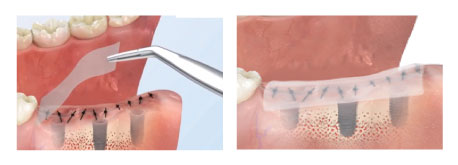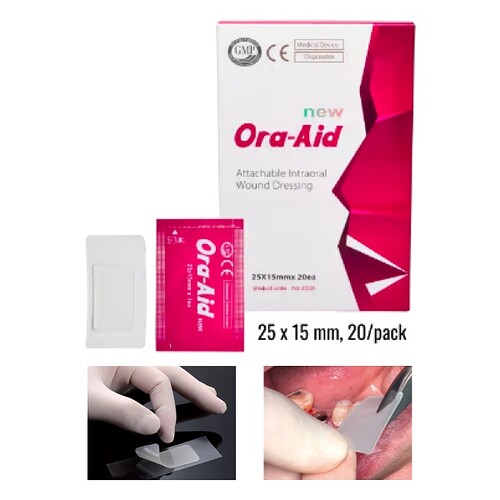Ora-Aid is an intra-oral non-eugenol dressing that has recently arrived to the US market (FDA 510-K approval was received in January 2022), though it has been used very successfully outside the US for several years already. Ora-Aid is unique in that the application of the dressing is incredibly easy, and yet extremely effective. Basically, it's a 3-step process of trimming, peeling, and pressing and you are done. Ora-Aid is comprised of 2 layers: an oral mucosa adhesive side and a protection side. When exposed to moisture, the adhesive side changes into a gel state to achieve adhesion to the wound area. Ora-Aid Protocols in Extraction Sites is a great webinar from Dr. Amos Yahav that reviews some of the main features/benefits of the material, when used in conjunction with a graft material (the webinar is focused on Bond Apatite, but the protocol would be similar for other grafting materials).
When the subject of non-eugenol wound dressings is brought up, obviously Coe-Pak (TM) comes to mind. Coe-Pak is arguably the most widely used periodontal dressing. It has excellent adhesive properties and is a proven solution. However, Coe-Pak has well-known limitations, including among others a poor appearance, and ill-defined setting time. Ora-Aid, however, requires no mixing, adheres almost immediately to the wound site, and is clear and thin. So we think Ora-Aid could easily replace Coe-Pak in many cases, especially in even simpler cases where you might not have even considered a dressing.
As regards to protection of sutures, membranes and other regenerative materials, Periacryl has long been an option, and an effective one. But, when it comes to ease-of-use, Periacryl certainly has issues, which are easily overcome with Ora-Aid. On the downside, however, Ora-Aid won't adhere to the site very long (~ 6 hours), but it can easily be sutured into place following the specific protocol provided the manufacturer. Basically, the suture protocol is a simple cross-horizontal mattress suture over the material, without ever suturing the material directly. The protocol is covered extensively in the webinar above, and there are a few other videos at the Ora-Aid page.
Like any area of dentistry, there is of course, some disagreement as to the particular uses cases for dressings (see Periodontal Dressing: A Review Article), but we think that most practitioners would agree that they are very beneficial in some cases, particularly when it comes to reducing postoperative pain, bleeding, and discomfort. Overall, given the unique characteristics of Ora-Aid, it seems possible that it could expand the use cases of dressings, and is therefore a very exciting addition to the wound care armamentarium.
Have you use Ora-Aid? What has been you experience with this material or any other wound dressings? Do you currently use a dressing to cover membranes and graft materials? Please leave your comments below.


